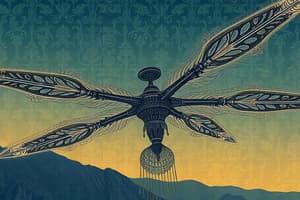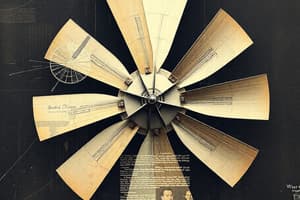Podcast
Questions and Answers
Which rotor blade design has a better aerodynamic pitch characteristic?
Which rotor blade design has a better aerodynamic pitch characteristic?
- Asymmetrical
- Symmetrical (correct)
- Tapered
- Uniform
What feature of asymmetrical rotor blades allows them to achieve similar aerodynamic stability to symmetrical blades?
What feature of asymmetrical rotor blades allows them to achieve similar aerodynamic stability to symmetrical blades?
- Increased thickness
- Increased camber
- Decreased chord length
- Swept edges (correct)
Why are symmetrical rotor blades more commonly used than asymmetrical blades?
Why are symmetrical rotor blades more commonly used than asymmetrical blades?
- They have lower drag
- They are easier to manufacture
- They have better lift
- They are more stable (correct)
Which rotor blade planform has a leading and trailing edge that run parallel to each other?
Which rotor blade planform has a leading and trailing edge that run parallel to each other?
Why do manufacturers prefer to produce uniform planform blades?
Why do manufacturers prefer to produce uniform planform blades?
Why do parallel blades have a negative twist from root to tip?
Why do parallel blades have a negative twist from root to tip?
What is a benefit of using bonded construction for rotor blades?
What is a benefit of using bonded construction for rotor blades?
How many trim balance weights are typically used on a rotor blade?
How many trim balance weights are typically used on a rotor blade?
What is the purpose of the stainless steel capping on the leading edges of rotor blades?
What is the purpose of the stainless steel capping on the leading edges of rotor blades?
Why are the bottom surfaces of rotor blades often painted flat black?
Why are the bottom surfaces of rotor blades often painted flat black?
Which type of rotor blades are required to have static discharge capabilities?
Which type of rotor blades are required to have static discharge capabilities?
What is the primary inspection method used for composite rotor blades?
What is the primary inspection method used for composite rotor blades?
Where are spanwise balance weights typically located on a rotor blade?
Where are spanwise balance weights typically located on a rotor blade?
If weight is added to the leading edge of a rotor blade, what effect will it have on the helicopter?
If weight is added to the leading edge of a rotor blade, what effect will it have on the helicopter?
How should you bend a trim tab to make the rotor blade fly lower in its plane of rotation?
How should you bend a trim tab to make the rotor blade fly lower in its plane of rotation?
What is the first control that should be rigged when working on a helicopter?
What is the first control that should be rigged when working on a helicopter?
What action is crucial before connecting the collective and throttle?
What action is crucial before connecting the collective and throttle?
What is the correct sequence for testing a helicopter after rigging?
What is the correct sequence for testing a helicopter after rigging?
Where is the servo tab located on a rotor blade?
Where is the servo tab located on a rotor blade?
What is a primary function of the main servo flap?
What is a primary function of the main servo flap?
In what order are the flight controls rigged?
In what order are the flight controls rigged?
Which system is considered more complex, a droop compensator or a correlator?
Which system is considered more complex, a droop compensator or a correlator?
What is the primary function of the droop compensator?
What is the primary function of the droop compensator?
What is the purpose of the correlator?
What is the purpose of the correlator?
Flashcards
Symmetrical Blade Design
Symmetrical Blade Design
A blade design with a symmetrical airfoil shape, offering better aerodynamic pitch characteristics.
Asymmetrical Blade Design
Asymmetrical Blade Design
A blade design with an asymmetrical airfoil shape, providing greater lift for the same surface area.
Parallel (Uniform) Planform
Parallel (Uniform) Planform
A blade planform where the leading and trailing edges run parallel to each other, resulting in constant chord length.
Tapered Planform
Tapered Planform
Signup and view all the flashcards
Blade Twist
Blade Twist
Signup and view all the flashcards
Bonded Construction
Bonded Construction
Signup and view all the flashcards
Single Pocket Skin Configuration
Single Pocket Skin Configuration
Signup and view all the flashcards
Multi Pocket Skin Configuration
Multi Pocket Skin Configuration
Signup and view all the flashcards
What happens when weight is added aft of the trim tabs?
What happens when weight is added aft of the trim tabs?
Signup and view all the flashcards
Why are rotor blade leading edges capped with stainless steel?
Why are rotor blade leading edges capped with stainless steel?
Signup and view all the flashcards
Why are rotor blades painted black on the bottom?
Why are rotor blades painted black on the bottom?
Signup and view all the flashcards
Why do composite rotor blades need static discharge capabilities?
Why do composite rotor blades need static discharge capabilities?
Signup and view all the flashcards
How are composite rotor blades primarily inspected?
How are composite rotor blades primarily inspected?
Signup and view all the flashcards
Which blade skin configuration is more expensive to build?
Which blade skin configuration is more expensive to build?
Signup and view all the flashcards
What do additional double plates on rotor blades do?
What do additional double plates on rotor blades do?
Signup and view all the flashcards
Where are spanwise balance weights located on a rotor blade?
Where are spanwise balance weights located on a rotor blade?
Signup and view all the flashcards
What is the servo flap?
What is the servo flap?
Signup and view all the flashcards
What are the benefits of the servo flap?
What are the benefits of the servo flap?
Signup and view all the flashcards
What does the droop compensator do?
What does the droop compensator do?
Signup and view all the flashcards
What is the correlator?
What is the correlator?
Signup and view all the flashcards
What is a bifilar vibration absorber?
What is a bifilar vibration absorber?
Signup and view all the flashcards
What is a hub vibration absorber?
What is a hub vibration absorber?
Signup and view all the flashcards
What returns the cyclic to its previous position in a force trim system?
What returns the cyclic to its previous position in a force trim system?
Signup and view all the flashcards
What is a fixed elevator and what does it do?
What is a fixed elevator and what does it do?
Signup and view all the flashcards
Study Notes
Rotor Blade Designs
- Two main rotor blade designs exist: symmetrical and asymmetrical.
- Symmetrical blades have better aerodynamic pitch characteristics.
- Asymmetrical blades generate greater lift for the same surface area, with higher camber on one side.
- Engineers achieve similar pitching characteristics in asymmetrical blades by sweeping the edges by 3 degrees upwards to achieve aerodynamic stability.
- Symmetrical blades are the most common design due to the asymmetrical blade's unstable aerodynamic characteristics.
- Two planform types exist: parallel (uniform) and tapered.
- Uniform planforms have leading and trailing edges parallel to each other.
- Uniform platforms generate greater lift due to their chord line.
- Tapered planforms have a converging leading and trailing edge, and decreasing chord length towards the blade root.
Manufacturing Preferences
- Manufacturers prefer uniform platforms due to cost-effectiveness.
- Uniform designs utilize a single machine stamping for ribs, as the chord line doesn't change, and only one rib part number is required.
- Tapered blade planforms require different rib numbers for each rib due to varying chord length.
- Tapered designs provide more equal lift across the blade due to accommodating variations in speed.
Blade Twist
- Parallel blades have a negative twist to achieve a higher angle of attack (AOA) at the root and compensate for slower blade spinning at the tip, ensuring equal lift across the blade's entire length.
Skin Configurations
- Single-pocket skin configurations are faster to build due to using one large skin.
- Multi-pocket skin configurations are easier to repair, as damaged skins can be replaced without affecting the entire structure.
Maintenance
- Replacing damaged skins is preferable for multi-pocket configurations.
- With single-pocket configurations, damage often leads to the entire skin's replacement.
Weight Balancing
- It is not possible to move chord line mass balance weights.
- Trim balance weights (two, typically) are adjustable only during repairs.
- Adding weights forward alters the blade's position downward in rotation
- Adding weights aft alters the blade's position upward in rotation.
Blade Tab Adjustments
- Adjusting trim tabs upwards will cause the blade to fly higher in its rotational plane
- Adjusting trim tabs downwards will cause the blade to fly lower in its rotational plane
Rotor Blade Materials
- Composite materials, metal, and wood are common rotor blade materials.
Blade Inspection
- Tap testing is a primary method for inspecting composite rotor blades.
Rotor Blade Construction
- Bonded construction techniques are preferred due to improved strength and prevention of drilling holes.
Vibration Mitigation
- Bifilar and hub vibration absorbers utilize various mechanical and construction methods to reduce noise and vibration during operation.
Helicopters
- Collective rigging happens first before performing other flight controls rigging on a helicopter.
- Turning off hydraulics, and ensuring no residual pressure remains in the hydraulic system, before rigging, helps avoid hydraulic malfunction.
Studying That Suits You
Use AI to generate personalized quizzes and flashcards to suit your learning preferences.




